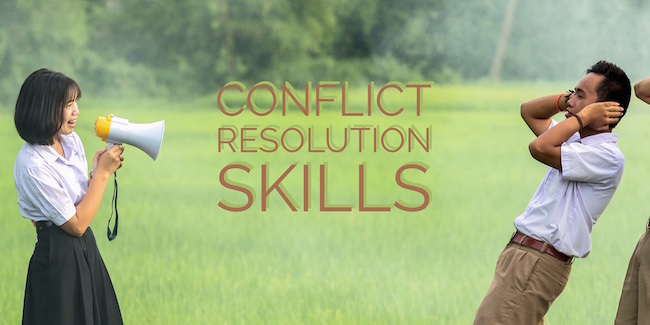Conflict resolution is a key business skill when dealing with situations that can arise with colleagues, contacts, customers, and clients. You need to understand the pieces of the puzzle that compose a solid conflict resolution strategy in order to strengthen client or customer satisfaction, maintain productivity, and avoid suffering damage to your reputation.
Table of Contents
ToggleThe Right Mindset for Conflict Resolution
When a situation arises that has led to conflict it is important to approach it with the correct mindset from the very outset. On the most fundamental level, you have to really, truly want to resolve the conflict before you start. Note that this is different from simply feeling like you should want to address the problem. Instead, you must have a sincere, genuine desire to seek a resolution before even beginning to take action to achieve the best result.
This also means ensuring that you create ‘win-win’ resolutions rather than pursuing a very dogged win-at-all-costs strategy. The latter can often appear to produce a good resolution for you, but that will likely create resentment in the other party. This, in turn, can manifest itself as negative action towards you and potentially breed future conflicts that will come back to the surface later.
Getting to the Core of the Problem
To provide a satisfying resolution to any conflict, it is vital to discover what the real problem is at its heart. It is not unusual for people, consciously or subconsciously, and for a variety of reasons, to mask the real reason for conflict with other differing reasons. Regardless of the intention, the outcome is the same in confusing exactly which problems need to be addressed to provide a resolution.
For example, when a customer who is waiting on a delayed delivery is angry and emotions are running high, they may be critical of other unrelated aspects of your business. Instead of arguing about each of these criticisms, it is better to get to the core problem, which is that they have lost confidence in your service and are worried about not receiving their important delivery. If this core problem is addressed, and you show empathy to your customer, then you have gone a long way toward creating a satisfactory conflict resolution.
Listen to Communicate Effectively
In order to fully understand the other person’s dispute, you need to ask questions and listen to their side of the story. You should also make sure that there are no misunderstandings by clarifying individual points within the issue.
This approach serves a dual purpose. First, you will have the correct information to genuinely understand the complaint and where it’s coming from. Second, you will be seen as a good listener, which of itself can disarm a previously heated conflict. Getting entrenched and defensive will not have the same positive effect that active listening and communication will.
Select from a Variety of Options
As with many problems, those requiring conflict resolution between parties may present a variety of possible solutions. It is important to enter into conflict resolution with these strategies already in your mind. It is the mark of a person skilled in conflict resolution that they come to the table with a variety of options as to how the problem could be fixed. This is in contrast to the inexpert person who comes solely focused on one possible outcome and ends up trying to force their own desired outcome whether or not it’s agreeable to the other party. Again, by showing imagination in your problem solving you will not only have more options at hand to resolve the conflict, but the other party will see that you have thought about the issue and shown it (and them) due respect.
Future Proofing the Relationship
Once a conflict has been resolved, there is still work to be done–namely, to ensure that it does not arise again. The last stage of conflict resolution is, therefore, one of the most important, or else you will be sapping productivity by resolving similar conflicts over and over again.
Use the positive momentum of resolving the conflict to briefly suggest and try to gain agreement for steps to ensure that such a conflict does not arise again. This may be a commitment by one of or both parties to a certain course of action or change in approach from this step forward.
Moreover, the final bonus step can be to apply the knowledge gained through resolving this conflict to other customer relationships where such a problem may potentially arise. In this way, one resolution can streamline the process of dealing with future issues and improve your business effectiveness.













